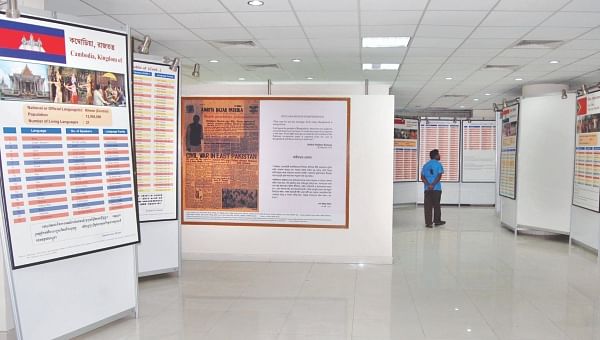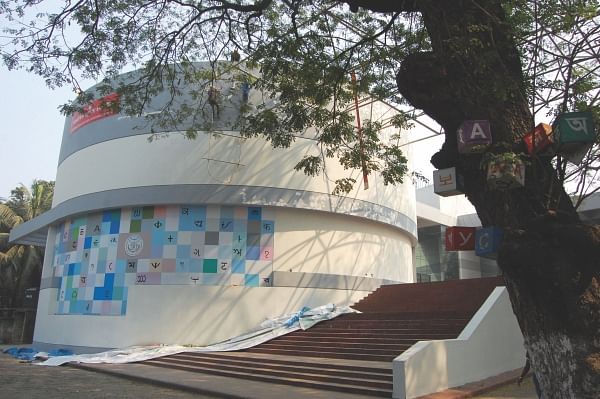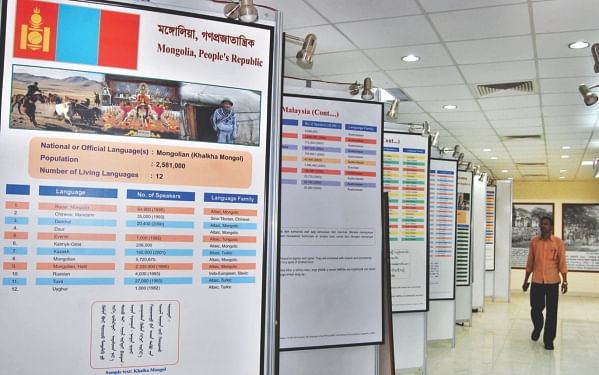SAVING LANGUAGES, PRESERVING KNOWLEDGE
 The language museum at the International Mother Language Institute is now open to the public. Photo: Prabir Das
The language museum at the International Mother Language Institute is now open to the public. Photo: Prabir Das
With an area that is one tenth of Bangladesh and population less than that of Dhaka city, Vanuatu, the island nation located in the South Pacific Ocean, has 108 living languages. Such fascinating information can be found at the museum of the International Mother Language Institute (IMLI), at Segunbagicha, Dhaka. The architectural beauty of the three-storied building studded with colourful alphabets of different languages, comes in view as one crosses the Kakrail intersection.
Inaugurated in March 15, 2001, the IMLI is the institutional outcome of the International Mother Language Day, which is being celebrated on 21st February since November, 1999. The main purpose of the IMLI is to preserve and protect endangered languages of the world as well as to develop languages that have remained on the fringe of modern civilisation. Dr Jinnat Imtiaz Ali, Professor of linguistics, University of Dhaka, Director General of the IMLI talks about languages that are gradually becoming extinct and obsolete as the number of speakers is gradually diminishing and the languages are not being used in modern culture, science and technology.
Explaining the need for preserving languages, Dr Jinnat Imtiaz Ali, Professor of linguistics, University of Dhaka, Director General of the IMLI says, “The end of a language means forfeiting decades-old knowledge, philosophy and morale of the speakers of that language. These resources have been passed down orally through generations. Since there are no writing systems, the outer world has no knowledge about these valuable resources. If these become lost forever then on a larger scale human civilisation will be the sufferer because we will never come to know about the knowledge, wisdom, and culture of that language.”
 The institute is working towards promoting Bangla and preserving endangered languages. Photo: Prabir Das
The institute is working towards promoting Bangla and preserving endangered languages. Photo: Prabir Das
The institute began its journey on 10 January, 2011, with a view to conduct research on different languages of the world including Bangla, develop and promote Bangla within and outside the country, collect, preserve and research languages of ethnic minorities, research on language movements, publish and upgrade dictionaries of different languages and introduce writing system for illiterate languages.
“Our main objective is to build this institute as a language planning and management academy and equip it as a higher studies research centre,” summarises Dr Ali. “Language planning entails converting illiterate languages to literate languages,” he says explaining that literate languages have writing system while illiterate ones don't. “Developing a language means introducing a writing system for that language,” he adds saying that it is the responsibility of people of literate languages to develop a writing system for languages that lack this aspect. Referring to the language policy of the government and the need for use of standard language, Dr Ali says that monitoring and follow up on implementation of the language policy will fall under the management function of the academy.
“Language is called the tangible and intangible phenomenon of culture,” Dr Ali says referring to the Universal Declaration of Human Rights, Linguistic Rights and Universal Declaration on Cultural Diversity. Our National Education Policy aims to provide primary education to children of indigenous and ethnic minority groups in their mother languages, which is a fundamental right. “How would you provide education to children in languages that are not literate?” he asks. Dr Ali informs that many textbooks have been published this year in the languages of the ethnic minority groups. Explaining the basic components of language – phonology, morphology, syntax, semantics and pragmatics, he emphasises the need of analysing and describing a language before developing a writing system for it so as to pave the way for publishing literature and textbooks of that language. “Thus language planning entails discovering the features of an oral language and preparing its grammar, primer and producing a dictionary,” he says.
To develop the various languages that are currently spoken in Bangladesh, the IMLI is planning an ethno-linguistic survey of Bangladesh. Dr Ali plans language documentation through revitalisation and revivalism. “In the first phase we will form an ethno-linguistic account or profile of Bangladesh,” he says adding that this process will reveal the number of languages used in this country. “Once we know that, we can do the works necessary for each respective language.” He informs that renowned linguists and anthropologists of the country have been requested to participate in this programme.
 The museum provides information about languages spoken
The museum provides information about languages spoken
in different countries of the world, their routes and families.
Already a pilot project on language documentation has been carried out in Moulvibazar where 20 different ethnic minority groups can be found, relates Dr Ali. Mentioning community participation as a popular process of language documentation, he says a language teacher or informant, who has extensive knowledge about the language of his/her community, will be developed from within a community. “S/he will create the language inventory and it will be done through an audio-video lingual process,” he informs. He says that the institute will provide logistic and intellectual support to these informants or researchers. An authentication board of international standard will in turn certify the findings by the community researchers about their languages. Based on the findings, the institute can develop the grammar and revive the language, which can be used in literature, media, and textbook and so on.
The institute also plans to provide scholarship to researchers and scholars who can associate themselves to the institute's area of work. Dr Ali says that research assistance will be provided for language documentation, learning, archives, computational linguistics and such other areas which will enrich the institute.
At present the institute has a complete infrastructural and administrative set up. It has also opened its language museum for the public, which displays the languages spoken in different countries in Asia and the Pacific, the number of speakers, language family and sample of text of the major languages of the country. The slides are from last year's 'language fair' prepared for the three- day international conference on 'Cultural Diversity Ministerial Forum of the Asia-Pacific Region- 2012', informs Dr Ali. The museum also provides a visual chronological account of the language movement of Bangladesh. Photographs of old Bengali scripts and its derivation are also displayed in the museum. For a quick visit to the roots of the words that we use in our daily lives a peek at the International Mother Language Institute is a must.

 For all latest news, follow The Daily Star's Google News channel.
For all latest news, follow The Daily Star's Google News channel. 




Comments